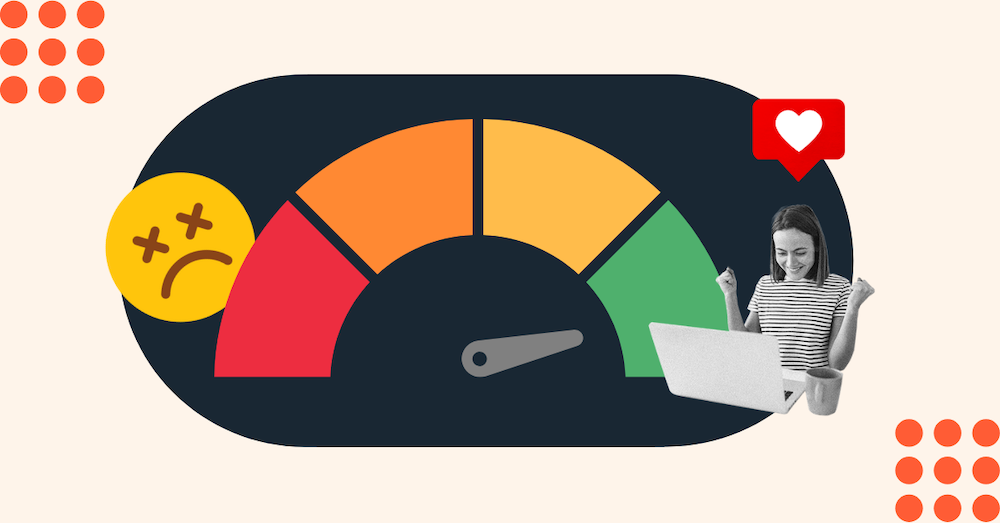Let's review what a key driver analysis looks like and how you can use one to improve the customer experience.
What is a key driver analysis?
A key driver analysis is a statistical technique you can use to determine the importance between potential factors — like product quality or price — and customer attitudes toward your brand. This helps you understand the drivers behind consumer behaviors and key business metrics such as customer satisfaction or loyalty.
A key driver analysis is especially useful when you're tracking the 'why' behind customer satisfaction scores such as NPS, CSAT, or CES. And if you're trying to come up with a strategy for your service team, this analysis will show you the specific factors that influence a customer's decision to give you a higher or lower satisfaction score.
As a result, you'll have targeted areas of improvement that you can work on to enhance the customer experience. You'll also have the power to make hierarchical decisions about what to focus on and when.
TL;DR: The best reason to use a key driver analysis is to understand what influences customer satisfaction and why. That way, you have the tools to improve it.
Next, let's dive into the benefits of conducting a key driver analysis.
Benefits of a Key Driver Analysis
A key driver analysis helps you understand the specific variables that impact your brand performance the most. You can use this analysis to figure out how your customers feel about your business and their likelihood to recommend you to a friend. A key driver analysis can also tell you what drives customers to make these decisions — and why.
Check out a few of the other benefits below.
You can better understand consumer behaviors.
It's not uncommon to make assumptions about why your customers behave the way they do. What's great about a key driver analysis is that it can confirm (or deny) those assumptions.
For example: Let's say you own a hotel. Even though your prices are cheaper than the competitor down the street, people are choosing them over you. You originally thought that price was the most important factor to consumers. But when you conduct a survey using key driver analysis, you may find that your customers actually value excellent customer service and room cleanliness much more than price.
If your competitor prioritizes those elements, that could help explain why your customers are taking their business elsewhere. And now you can tweak your business strategy to better cater to their needs.
Another way to look at it is this: Your success as a business is based on how much you know about your ideal customers.
In the below episode of the "MarTech" podcast series, hosted by the HubSpot Podcast Network, Roli Saxena discusses the importance of understanding the drivers that make customers aware of and loyal to your business.
Saxena is the President of AdRoll Business at NextRoll. Listen in for some tips from Saxena on how you can use these drivers to your advantage — especially in the ecommerce world.
You can use the results to improve the customer experience.
Circling back to catering to customer needs, a key driver analysis gives you a better understanding of the value that customers place on specific aspects of your company. And you can use that to your advantage.
Sticking with the hotel example above — now that you know excellent customer service and room cleanliness are important to your customers, you can revisit your business structure to emphasize those features.
Hire a more advanced cleaning crew. Retrain your service staff in empathy and hospitality. Use what you know to get customers in the door.
You can predict outcomes of potential business decisions.
Once you have a good idea of what drives customer satisfaction, you can use that framework to predict how customers may react to prospective business scenarios.
Like, what would happen if you increased the price at your fictional hotel? The impacts would depend on how important price is across the customer satisfaction rankings. If it ranks highly, chances are customer satisfaction will decrease if the price goes up.
And vice versa.
How to Do a Key Driver Analysis
To do a key driver analysis, you'll need to start by sending a survey that asks about potential drivers and an overall satisfaction score. The satisfaction score could be represented by NPS, CSAT, or CES.
As a hotelier, your survey could ask about the importance of different elements related to the customer's stay — such as price, customer service, cleanliness, food, or the check-in and check-out process. Then, as shown in the image below, you can wrap things up by asking how satisfied they were with their overall experience.

This information will help you see how much those factors (customer service, cleanliness, etc.) influence your customer satisfaction scores.
Once you collect the data, a key driver analysis will use multiple linear regression to analyze the data. Using the regression model, you'd take your survey scale (usually from 1 to 5), calculate the average weighted score for each factor, and then determine the correlation between factors.
So if an element like cleanliness has a higher weighted value than price — and a higher correlation with overall customer satisfaction — this should become a priority for your business.
Now that we know how a key driver analysis works, let's take a closer look at what the results might look like.
Key Driver Analysis Quadrants
After you've sent the survey and have charted the information using your weighted averages and correlation coefficients, you'll get back a graph that looks something like this.

On the top left, you'll see drivers that are important but have a poor rating. This means customers care about these factors (e.g., customer service), but your business isn't doing a good job here. Boo.
On the top right, you'll see drivers that are important and have a high rating. This means customers care about these factors, and your business is doing a good job here. Yay.
On the bottom left, you'll see drivers that are not important, but also poorly rated. This means customers don't care about these factors as much, and your business isn't doing a good job here.
And then on the bottom right, you'll see drivers that aren't important but are rated highly. This means customers don't care about these factors as much, but your business is doing a good job here.
Below are more details on how to read the quadrants in your key driver analysis chart.
Reading a Key Driver Analysis Chart
When you're looking at the drivers placed in each quadrant on a grid like the above, it's important to pay attention to the key weaknesses (top left) and key strengths (top right).
Your key weaknesses will give you areas to focus on so you can increase your customer satisfaction scores. The key strengths let you know what to continue doing well on.
While the bottom drivers don't influence satisfaction scores as much, it's still a good idea to see what you're doing well and what is being rated poorly. Even if the factors themselves aren't as important to customers.
So, how can you put this methodology into practice at your company? Check out some helpful tips ahead.
Putting a Key Driver Analysis Into Practice
To conduct a key driver analysis on your own, you can either use a survey software that can create the report for you, or you can gather the data yourself.
Software like CheckMarket can create this report right in your dashboard. If you use survey software to conduct your customer satisfaction surveys, you can check to see if it has the capability to run a key driver analysis report.
If you don't have software available, you can use the survey data you gathered to run a key driver analysis in Microsoft Excel.
You'd start by calculating your average scores and then using the correlation formula in Excel to determine the importance of each factor. You can then put those correlation numbers on a quadrant chart, and use the analysis above to help you read the chart.
Once you know which factors are most important to your customers and have a low rating, you can begin brainstorming ideas for how to improve those at your company.
Running a key driver analysis can help you focus your efforts on customer retention and improving customer satisfaction scores. This tool will let you know not only what's rated highly and poorly, but also which factors are the most important to create the optimal customer experience.
Customer Satisfaction
.png?width=112&height=112&name=Image%20Hackathon%20%E2%80%93%20Vertical%20(9).png)



![Big Brands That Lost Customers' Satisfaction [Where CX Went Wrong + Data]](https://53.fs1.hubspotusercontent-na1.net/hubfs/53/companies%20that%20lost%20customers_featured.png)


![23 Excellent Customer Satisfaction Survey Examples [+ Templates]](https://53.fs1.hubspotusercontent-na1.net/hubfs/53/customer-satisfaction-survey-example_0.webp)




![How To Design Customer Satisfaction Surveys That Get Results [+ Templates]](https://53.fs1.hubspotusercontent-na1.net/hubfs/53/customersatisfactionsurvey.webp)